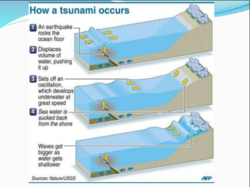Earthquake rupture
Topic: Earth
 From HandWiki - Reading time: 4 min
From HandWiki - Reading time: 4 min
One of the many common features of the Earth's internal and external systems is the process of earthquake ruptures. Generally, an earthquake rupture refers to a slip, whether on the surface or beneath, in the Earth's crust that results in a fault and displacement of some sort. Earthquake ruptures occur for many reasons that include: landslides, an eruption of a volcano, the formation of a new fault, or a slip on an existing fault.[1]
More generally, earthquake ruptures happen because the rocks, either in the crust or farther under the surface, undergo a certain amount of stress and strain that eventually breaks and releases seismic energy. To understand the process of a rupture, simply consider a block of rock held tightly by two clamps. If both clamps move in opposite directions, the block will experience bending. As the clamps put more strain on the rock, cracks will begin to form and eventually more strain will cause the block to crack. The crack caused by the strain is an example of the fault that forms after such strain. Although this example is highly simplified, it demonstrates how stress and strain can break and deform rocks; leading to an earthquake rupture (refer to Figure 1 for an example of stress and strain).
Other geologic and natural features associated with earthquake ruptures will be explored and explained, specifically the kinds of damage. Some of these associated effects include soil liquefaction, tsunamis, and landslides.
The first associated risk of earthquake ruptures is sediment liquefaction. According to the Earthquake Glossary by the United States Geological Survey, liquefaction is defined as, "A process by which water-saturated sediment temporarily loses strength and acts as a fluid, like when you wiggle your toes in the wet sand near the water at the beach. This effect can be caused by earthquake shaking."[2] Because it is known that earthquake ruptures release and propagate seismic energy, the effects of that energy on a building sitting on loose sediment is particularly hazardous. For an earthquake rupture whose energy spreads near a beach residential area, the seismic energy will increase with the sediments low-frequency and high amplitude waves. In turn, such seismic energy has potential to topple over or completely destroy buildings atop this kind of sediment (refer to Figure 2 for an example). Tsunamis are another geologic feature that are commonly associated with earthquake ruptures.
Tsunamis also provide another case whereby the seismic energy released from an earthquake rupture causes damage on and offshore. Literally meaning "harbor wave," tsunami's are shown to create large waves that travel more than 500 miles per hour. First and foremost, tsunami's require substantial seismic energy to displace its high volume of water. Although other factors can create tsunami's, high earthquake magnitudes are key in displacing water, especially when the earthquake happens near a subduction zone. In this case, the earthquake rupture occurs, causing the ocean floor to rise or drop. The water will then seek to level itself out, but will do so by propagating in a certain direction (see Figure 3 for a visual representation). The potential for these fast traveling waves are particularly damaging to coastal cities, or harbor towns. Buildings, cars, and other debris can be swept up and put elsewhere. The 2011 Tōhoku earthquake generated a devastating tsunami whose damage was estimated in the millions.
Lastly, landslides are another geologic feature that can occur from an earthquake rupture. One way or another, landslides involve the movement of rocks, sediment, and other materials; this movement can either be cohesive or fragmented.[3] If an earthquake rupture were to occur, for instance in a hilly residential area, the seismic energy would have potential to disturb the underlying sediment, especially if the sediment were saturated and weak. If the magnitude were big enough, the sediment of the slope would fail, causing any complexes to fail as well (refer to Figure 4). Much like how a tsunami can pick up debris on and off the ocean, landslides can also carry debris and put it elsewhere. Like the many ways an earthquake rupture can occur, there are many kinds of landslides.
See also
- Earthquake duration magnitude
- Earthquake magnitude
- Surface Rupture
References
- ↑ Stephen Marshak, Earth: Portrait of a Planet (New York: W. W. Norton & Company, 2001): 305–6.
- ↑ "Liquefaction," in Earthquake Glossary of the United States Geological Survey, date accessed: April 23, 2017. https://earthquake.usgs.gov/learn/glossary/?term=liquefaction
- ↑ Simon J. Day, "Landslides," in Encyclopedia of the Natural World Ser.: Encyclopedia of Islands ed. Rosemary Gillespie and David Clague (California: University of California Press, 2009): 535.
- National Oceanic and Atmospheric Administration, "Tsunami Frequently Asked Questions," date accessed: May 10, 2017. http://www.tsunami.gov/?page=tsunamiFAQ
External links
- Tsunami Strike Japan – Ocean Today
 KSF
KSF


